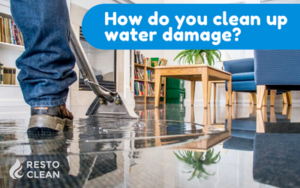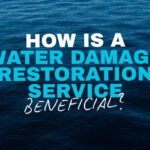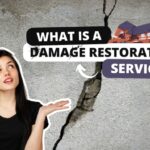
Water damage can be a severe problem for homeowners, as it can lead to mold growth, structural damage, and other issues. Cleaning up after water damage is vital in preventing further damage and restoring your home to its original condition.
If your home floods and the police or fire department tells you it is safe to return, you must find the fastest way to clean up the mess before mold grows.
Even though you may want to hurry back home and start cleaning up, be careful because there may be dangers you can’t see.
The Environmental Protection Agency (EPA) says that a flooded home or area should be checked to ensure it is safe and that there are no structural, electrical, or other dangers.
Meanwhile, here are the steps to take to clean your home after you are reasonably sure that it is structurally sound and secure to enter.
Wear protective gear
When water has gotten into your home, you should worry about more than just the water. During floods, the water carries dirty water from storm drains, ditches, and sewer lines. They may leave mud and dangerous substances in your home as they go away.
The EPA says that exposure to sewage or mold can result in some allergic reactions and other problems. For instance, mold can worsen asthma and make breathing hard.
To keep yourself safe, dress in clothing that covers your arms and legs. Wear a face mask to avoid inhaling mold spores and toxic fumes, goggles to protect your eyes from dust and small particles, and rubber gloves to protect your hands from cuts.
Individuals with a compromised immune system should avoid entering the house because mold, cleaning chemicals, and sewage in storm runoff can make them feel poorly.
Assess the damage
The first step in cleaning up water damage is assessing the extent of the damage. This involves looking for signs of water in areas that don’t usually get wet, such as behind walls or carpets. You should also look for signs of mold or mildew growth, which can indicate that there is standing water in the area. Once you’ve identified all areas affected by water damage, you can begin cleaning it up.
If you have flood insurance, document the extent of the damage to file a claim. You only have 60 days to send a proof of loss form showing what was damaged or lost in your home.
Call your insurance company to ensure they will cover any claims on water damage. Find out what documentation you will need to support your claim. For example, you may need to save carpet, flooring, and wall pieces, as well as take photos of the extent of the damage. Some insurance providers may even want to use a video chat to inspect your property remotely or fly a drone over your neighborhood to film the damage and assess it.
Remove standing water
Once you have identified all areas affected by water damage, it’s time to remove any standing water from the site. This can be done with a wet/dry vacuum or by using towels and buckets to soak up as much standing water as possible. If there is a large amount of standing water, you may need to use a pump to remove it from your home. Ensure all standing water is removed before proceeding with any other steps in the cleanup process.
Dry out your home
Mold begins to grow in damp places within 24 hours, and visible colonies can form within two days if it is warm.
The initial step in mold removal is ventilation. If you have electricity, turn on your air conditioner, dehumidifier, and fans. Keep your windows closed to help the airflow and eliminate excess moisture. If you only have fans, keep your windows open and direct the exhaust toward an open window. If you do not have power but a portable generator, use it to carry out the above strategy. Remember that generators emit lethal carbon monoxide; never run a generator indoors to avoid carbon monoxide poisoning. Put it at least 20 feet from your home, with the exhaust facing away. Open all your windows and doors if the weather permits.
Keep an eye on the humidity
Use a humidity meter to monitor your home’s moisture level while airing it out. The EPA recommends maintaining humidity levels between 30 and 50 percent to prevent mold growth.
Mold and bacterial growth can exist even when floors, walls, and furniture are dry to the touch. A moisture meter is another helpful tool for detecting dampness that you cannot see.
Clear the debris
Wear your respirator and other protective equipment before disposing of contaminated debris.
The IICRC (Institution of Inspection Cleaning and Restoration Certification) recommends removing wet silt and debris from your home with shovels or rakes and depositing it safely away from your home. Also, thoroughly clean and sanitize your clothes and shoes, and disinfect your tools with bleach.
If any household items, such as furniture or carpeting, have been damaged and you cannot clean and dry them within two days of your home being flooded, it is better to discard them. These items are most likely moldy and cannot be saved. Take a photo of any valuable items that must be disposed of for your insurance claim.
Inquire with your municipality’s sanitation department about how to dispose of household items from your clean up.
Take down damaged drywall
If your home’s drywall has more than 10 square feet of total water damage, the EPA recommends hiring a contractor with water damage experience to remove it. If the affected area is smaller, you can handle it independently.
If the insulation behind the drywall is damp, you will also need to remove it. Nonporous materials like metal and glass can be cleaned with water and detergent and sanitized with a bleach and water solution.
Wait to install new insulation or drywall on walls until everything is completely dry.
Take out the flooring
Ceramic tile, sheet vinyl, laminate, and solid wood floors should be removed even if they appear dry because moisture and silt collect beneath them and cause bacteria or mold to grow.
After you have disposed of these, ensure everything is clean and dry before installing new flooring. Maintain your home’s humidity level between 30 and 50 percent, and use a moisture meter to ensure that the subflooring is at or below 16 percent moisture content before installing new flooring. Manufacturers recommend a moisture content for wood floors of 13 percent or less. Your flooring may take a few weeks to dry completely.
You should consult professionals if you need help determining when to reinstall flooring.
Thoroughly inspect appliances and disinfect affected areas
Whatever you do, do not immediately plugin or provide power to your appliances because their components may have been corrupted or damaged by flood waters.
To be safe, discard any appliance submerged in flood water, such as your washer or stove. If you believe an appliance can be saved, hire a professional repair person to inspect it before resuming use.
While mold does not grow well on metals or ceramics, you should still wipe everything down with bleach to sanitize and kill any potential mold.
If there is no visible mold, you may clean most nonporous surfaces, such as the metal on appliances, with 1 cup of bleach to 5 gallons of water.
If you notice mold growth, dilute 1 cup of bleach in 1 gallon of water. Before using items, rinse or wipe them down and let them air dry completely.
Hire a legit restoration company
The role of a restoration company in the cleanup process after water damage is to assess the extent of the damage, develop a plan of action, and execute that plan to restore the affected area to its pre-loss condition. If you realize that you cannot handle the situation independently, do yourself a favor and get expert assistance.
Conclusion
Water damage can be a major disaster for any home or business. The consequences can be severe and long-lasting, whether from a broken pipe, a flood, or a leaky roof. The key to minimizing the damage is to act quickly and take the proper steps to clean up the mess.
Resto Clean is a top-rated company for water damage restoration in Wasilla. They collaborate with licensed industrial hygienists and engineers to perform mold remediation for residential and commercial buildings. The company also adheres to the IICRC’s standards for microbial growth and satisfies all EPA regulations. You can contact them for assistance if you have any water damage concerns.





